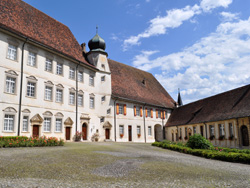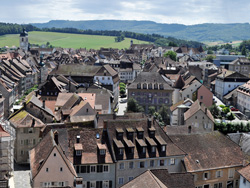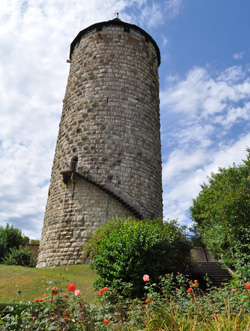| Porrentruy
Jura Tourisme
Grand-Rue 5 - Case postale 67
CH-2900 Porrentruy |  | Tel. +41 32 420 47 72
Fax +41 32 420 47 82 |
Economic capital of Ajoie, Porrentruy is, along with Delémont and Saint-Ursanne, one of the three historic cities of the Jura. Formerly part of the Bishopric of Basel, it became the residence of the Prince-Bishops in 1527 when the Reformation caused them to flee the large city on the banks of the Rhine.
It is a city steeped in history, with many witnesses to the past: the castle, the churches of St. Peter and St. Germain, the college of St. Charles, the picturesque old town with its Gothic, Baroque and neo-classical buildings. A must for any visit to the Jura!
The period of the prince-bishops was a golden age for the town but ended in 1792, when the French Revolution inspired the local guilds, leading to riots and the intervention of the revolutionary armies. Porrentruy then became part of the short-lived Rauracian Republic, annexed by France in 1793 to become the Department of Mont-Terrible, which chose the former city of the prince-bishops as its chief town.
The rest of the story was just as eventful: the French region of Montbéliard was attached to the Department of Mont-Terrible in 1797 and then, by the will of Bonaparte, the whole territory was attached to the Haut-Rhin in 1800, with Colmar as its capital.
And it was in 1815, by decision of the Congress of Vienna, that Ajoie and the rest of the Jura were allocated to Switzerland. But not as a new confederate canton: the Jura was offered to the canton of Bern to compensate for the loss of Vaud and Upper Aargau... Swiss history is a very complicated business!
The French-speaking and rebellious Jura people could not accept being swallowed up by a German-speaking and centralising canton: in 1917 a "Committee for the creation of a canton of Jura" was set up and it was not until 1978 that this canton was officially created, but amputated of all its southern territory.
A never-ending story... Since then, new votes have determined further changes in this "new" canton nearly 50 years old... |
 



|
 

|